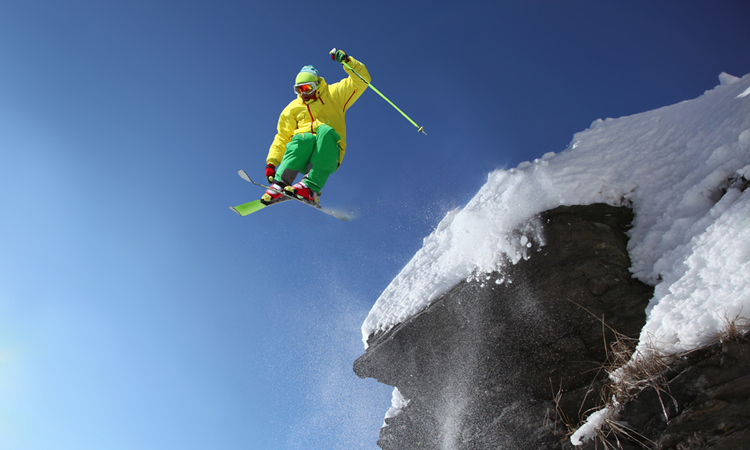
When I was in my early 20s, my brother—an avid black-diamond skier—decided to teach me to ski. He and a college buddy took me to a popular resort in New Hampshire, rode up with me to the top of the mountain, taught me how to fall down, then said they’d see me at the bottom of the trail. I looked down the snowy mountain full of slaloming skiers and wondered how I was going to make it to the base.
After a few moments I decided to throw caution to the wind and “just tuck and go,” as my brother had instructed. Crouched over my skis with poles parallel at my sides, I shoved off and blasted down the mountain—a flying terror full of speed but zero skill. It was a crazy and risky decision. I shot down the mountain yelling warnings and ultimately careened over the edge of the trail (yes, I was that skier you see stuck in a bush with legs up in the air). Still, I loved every second of the wind whipping in my face, the sense of freedom as I glided and skittered over the icy trail, the sound of crunching snow, and even the sudden stillness of lying on my back, face up to the brilliant blue sky.
That was 25 years ago. My adult life was just getting started; my only obligations were to myself. Back then I had the freedom to be reckless. I would never do that today. In fact, my brother recently begged me go skiing with him and, while I went to the mountain, I spent my time reading in the lodge. I’ve discovered I’m now more of an après ski kind of girl. I don’t want to end up in a bush or, worse, in traction.
Am I more risk-averse because I’m older and wiser, or did I just become a coward in the past two decades?
The Role of Age in Risk Tolerance
It’s easy to understand that the development of a mature lifestyle can induce fear of consequences. Children, careers, and other responsibilities make any kind of danger much less tolerable. When it comes to the literature on risk taking, however, there hasn’t yet been a definitive answer to how age affects risk tolerance or aversion. While a slew of research exists on the difference between risk-taking approaches and behaviors in young adults and older generations, the results are mixed. Most of the findings suggest that age itself has little to do with our risk behavior.
Some research (using experimental models concerning finances, investing, and gambling) proves that older adults are more conservative in their choices, especially past the age of 65. Conversely, other studies indicate that older adults tolerate greater financial risk. Still others demonstrate equal tolerance in all age groups.
Separating out the conflicting experiments reveals a risk-aversion strategy that might favor youth—due partially to cognitive deficits that develop in older age and partially to other influential factors. Some theories about the difference in young versus old risk tolerance include:
Reduced gray matter. In a recent study published by the Journal of Neuroscience, researchers discovered that the less gray matter subjects had, the less risky their responses in the experiment. These results coincide with an earlier study whose findings indicate that the cortex becomes thinner with age, which suggests a correlation in risk-reduction behavior.
Affective versus deliberative strategy. We make decisions in two ways: based on feelings or based on critical examination of an issue. Research suggests that older adults experience a reduction in critical faculties while their affective capabilities remain intact, leading them to use emotion often when making decisions. In an experiment designed to trigger either affective (“warm”) or deliberative (“cold”) decision making, older adults were actually more risk-tolerant in the deliberative process.
Experience with a task. In studies oriented specifically toward gambling, results show that initially young and old show equal risk-taking behavior, but the older population employs a more affective strategy (focusing less on losses) and increased risk taking over an extended period of time, as they became more accustomed to the task involved in the experiment.
Task context. Studies of task context (i.e., characteristics) show that age differences are secondary to learning when subjects engage in tasks that are influenced by experience. For example, older adults appear risk-averse when a task rewards risk-seeking behavior and risk-seeking when the task involves risk avoidance.
Positive and negative emotions. While only a small number of studies have focused on the role of emotions, the findings are intriguing: Older adults are more likely to be influenced by positive emotions and, in the presence of a positive mood, to choose more risk-taking actions. Conversely, younger adults are more influenced by negative emotions and, in the negative mood, more likely to take risk.
Looking at all the research, I’m still not sure how to interpret my present-day reduced risk tolerance. I’m in middle age versus old age, so worst-case scenario: my thinning cortex accounts for my lower risk tolerance; best-case scenario: I just don’t feel comfortable enough with my experience of skiing to continue engaging in such risky behavior.
Whatever the answer, I’ve taken up dance as an alternative way to feel freedom in body and spirit. Though my partner has dropped me one or two times as we practice a lift, I can much more comfortably tolerate the risk of falling 4 feet down to the dance floor than going over the edge of a mountain into another bush.
What do you notice about how your risk tolerance has changed over time?
To find out about Rose’s thoughts on how to live a happier life, click here



1 Comment
Rosemary
Taking risks is all apart of life and I appreciate that his article focuses on the importance of risk-taking and how it keeps us young.